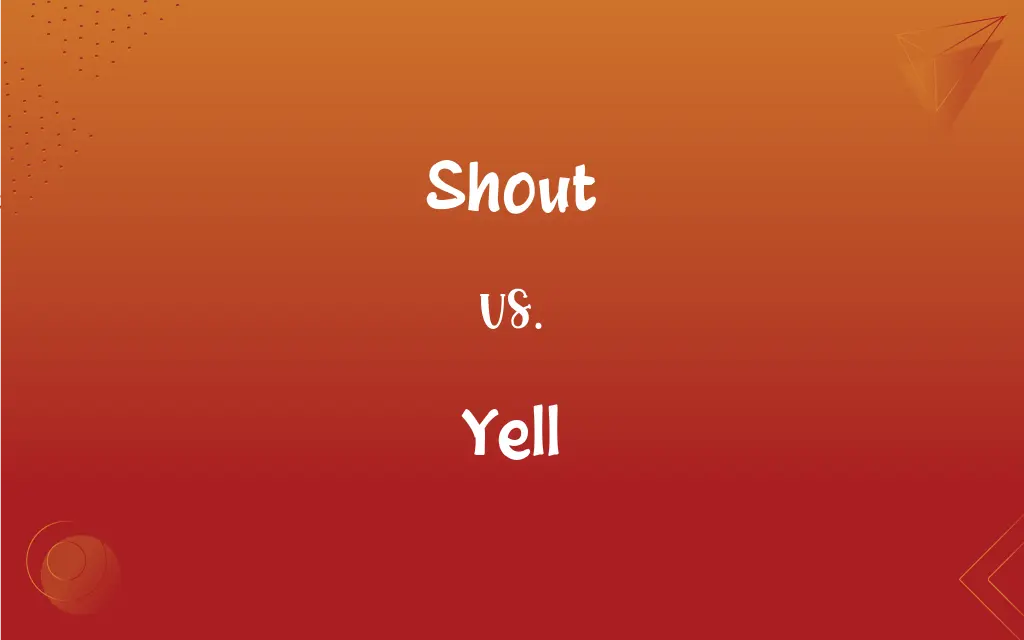Shout vs. Yell: What's the Difference?
Copy edited by Aimie Carlson || By Harlon Moss || Updated on November 18, 2023
Shout and yell both involve loud vocal expressions, but shouting is often used for communication over distance or noise, while yelling implies a stronger, more emotional or aggressive tone.

Key Differences
Shouting is typically used to attract attention or communicate over a distance or through noise. Yelling, on the other hand, often conveys urgency, aggression, or strong emotion.
Both shouting and yelling involve high volume, but the tone of yelling is usually more intense. Shouting can be authoritative or informational, whereas yelling is often associated with anger or fear.
In a crowd, one might shout to be heard, but yell in a moment of panic or anger. A coach may shout instructions during a game but yell to express frustration or motivation.
The perception of shouting versus yelling can vary culturally. In some contexts, shouting is seen as more acceptable, while yelling might be considered inappropriate or aggressive.
Shouting can be a neutral act of raising one's voice, but yelling is more likely to be associated with negative emotions and can be more physically straining.
ADVERTISEMENT
Comparison Chart
Intended Use
For attention or communication
Express urgency, aggression, or emotion
Tone
Can be neutral or authoritative
Generally more intense and emotional
Typical Situations
Overcoming noise, distance
Moments of panic, anger, urgency
Cultural Perception
Often seen as less aggressive
May be viewed as more aggressive
Emotional Association
Neutral or informative
Often negative, like anger or fear
ADVERTISEMENT
Shout and Yell Definitions
Shout
To call or cry out loudly and vigorously.
He shouted for help from the other room.
Yell
To scream with strong emotion or fear.
She yelled in terror when she saw the spider.
Shout
To express or utter with a shout.
She shouted her excitement at the concert.
Yell
A loud, sharp cry, especially of pain, surprise, or delight.
His yell startled everyone in the room.
Shout
A loud call or cry.
His shout echoed through the hallway.
Yell
To shout loudly, especially in a harsh or aggressive way.
The player yelled in frustration after missing the shot.
Shout
To cheer loudly in support or enthusiasm.
The fans shouted in unison to support their team.
Yell
To express or utter something loudly.
They yelled their disapproval during the speech.
Shout
To communicate loudly to be heard over distance or noise.
The coach shouted instructions from the sidelines.
Yell
To vociferate; to cry out loudly and vehemently.
He yelled at the team to get their attention.
Shout
A loud cry.
Yell
To cry out loudly, as in pain, fright, surprise, or enthusiasm.
Shout
To say with or utter a shout.
Yell
To utter or express with a loud cry.
Shout
A loud burst of voice or voices; a violent and sudden outcry, especially that of a multitude expressing joy, triumph, exultation, anger, or great effort.
FAQs
Can shouting be used for cheering?
Yes, like shouting in support at a sports event.
Is shouting always negative?
No, it can be neutral, like shouting to someone across a room.
What does yell imply?
A loud, often aggressive or emotional outcry.
What does it mean to shout?
To call or speak loudly, often to be heard over distance or noise.
When is yelling used?
Often in situations of anger, fear, or strong emotion.
Is yelling always loud?
Typically, it involves a high volume and intensity.
What's a common reason for shouting?
To attract attention or communicate in noisy environments.
Can shout and yell be used interchangeably?
In some contexts, but they have different connotations.
Is shouting more acceptable in public than yelling?
Generally, yes, as yelling can be seen as more aggressive.
Are there health implications for shouting or yelling?
Prolonged yelling can strain the voice; shouting is less likely to do so.
How do children typically use shouting and yelling?
For attention or during play (shouting); in distress or tantrums (yelling).
What is the effect of yelling on others?
It can be startling, intimidating, or convey urgency.
Can shouting be a form of expression?
Yes, it can express excitement, support, or urgent communication.
Does yelling always indicate anger?
Not always, but it's commonly associated with negative emotions.
Does literature differentiate between shout and yell?
Often, with context providing clues to the intended meaning.
What emotions are usually associated with yelling?
Anger, frustration, or panic.
Can yelling be effective in getting someone's attention?
Yes, but it may also be perceived as aggressive.
What is a 'battle shout'?
A loud cry used to express determination or boost morale in a group.
How does culture influence the perception of shouting and yelling?
Cultural norms dictate what is considered loud or aggressive communication.
Is shouting used in emergency situations?
Yes, often to alert or communicate urgently.
About Author
Written by
Harlon MossHarlon is a seasoned quality moderator and accomplished content writer for Difference Wiki. An alumnus of the prestigious University of California, he earned his degree in Computer Science. Leveraging his academic background, Harlon brings a meticulous and informed perspective to his work, ensuring content accuracy and excellence.
Copy edited by
Aimie CarlsonAimie Carlson, holding a master's degree in English literature, is a fervent English language enthusiast. She lends her writing talents to Difference Wiki, a prominent website that specializes in comparisons, offering readers insightful analyses that both captivate and inform.































































